Motorola Droid X: Thoroughly Reviewed
by Brian Klug on July 20, 2010 4:27 PM EST- Posted in
- Smartphones
- Motorola Droid X
- OMAP
- Mobile
Screen
The X, like the original Droid and HTC EVO, uses a traditional LCD TFT display instead of AMOLED like we’ve seen in the Nexus One and HTC Incredible. As noted earlier, the X also keeps the same FWVGA resolution as the original Droid, but increases screen size to 4.3 inches.
The result is that PPI drops from 266 on the Motorola Droid to 228 on the X. The EVO uses a more Android standard 800 x 480 WVGA resolution, but has slightly lower PPI at 217. The end result is that pixels are more visible on the EVO than the X, losing out to the original Droid. For reference the iPhone 4 comes in at 330 PPI.
One of the first things that struck me about the X’s screen was that it appeared undersaturated at first glance. To some extent, this is the result of me being used to looking at oversaturated Android elements on AMOLED devices. I’ve only spent a limited time with the EVO display, but it looks like HTC has increased saturation to make it look comparable to the HTC Incredible.
It’s more than likely that what the display looks like on the X is actually how the Android UI really looks. This could be a problem of perception for people that buy the X; even though the display itself might be more representative of what colors really look like, because it isn’t oversaturated (and thus what people are used to seeing), it might set wrong impressions about color accuracy.
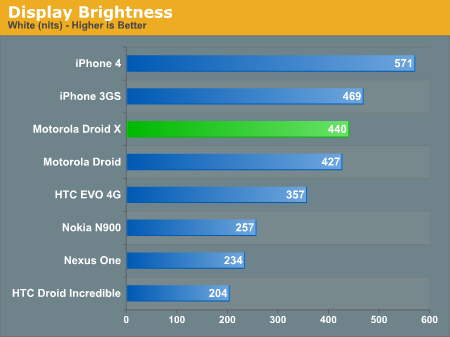
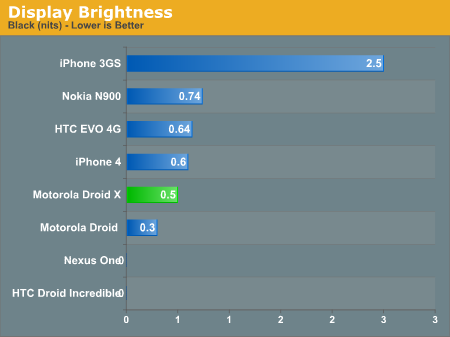
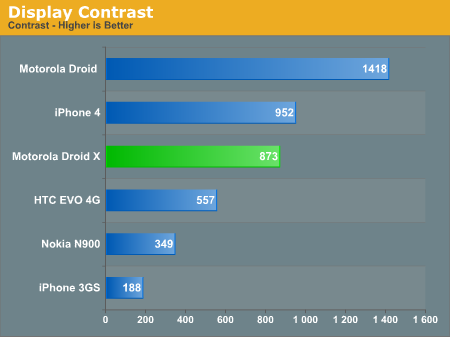
As noted before, the HTC Incredible and Nexus One displays show 0 nits of brightness on our i1D2 colorimeter, so contrast is technically nearly infinite, which is why they’re omitted from the contrast chart.
Outdoors, smartphone displays still photograph poorly and don't look great either. However, I found the X to be no less enjoyable than any other device outside if you were patient and careful to keep it in the shade.
Speakerphone
In keeping with our smartphone reviews, I measured the loudness of the X’s speakerphone using an Extech sound meter 6 inches above the display of the device. I call an automated weather report ASOS number, and wait for the call to complete. The average loudness in dBA is reported below. In all cases, ambient noise floor is a controlled 51.8 dBA.
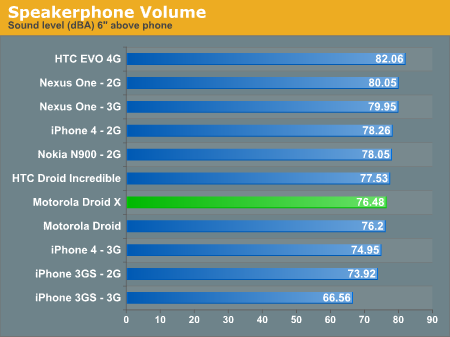
If you’ve been paying attention, you’ll notice I updated the display and speakerphone charts with data from the HTC EVO since Anand sent his my way. Here, we see the EVO 4G taking the loudness crown by a decent margin. The X’s speakerphone is decently loud, but not the absolute loudest in the pack.




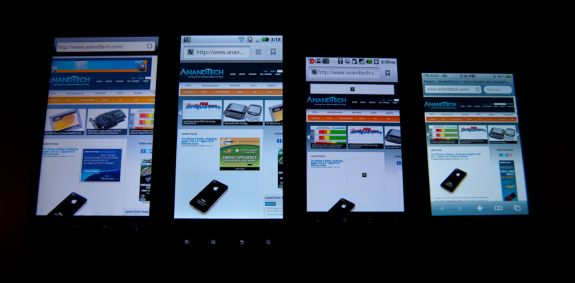
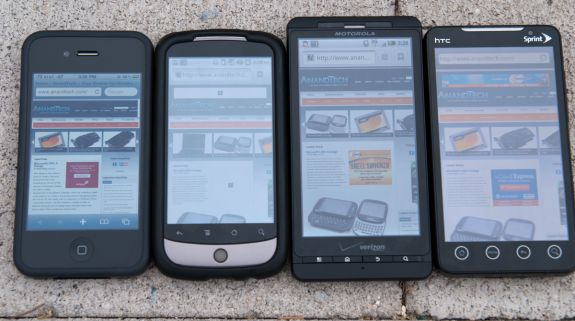














89 Comments
View All Comments
homebredcorgi - Tuesday, July 20, 2010 - link
Who do we have to blame for the “Droid” moniker? Verizon or Motorola?I have a Nexus One and continually get asked, “Is that a Droid?” or “Does that run Droid?” to which I usually reply yes and let sleeping dogs lie…but seriously, why name it so similar to the operating system? And then why make “Droid” a series of phones if your first phone is just known simply as “Droid”?! At least call it the "Droid One" or something to differentiate from the series of phones....
So now we have the Droid, Droid Eris, Droid X, and will soon have the Droid 2 which are all phones in the Droid series, all running on various builds of Android. Yeesh. Could they have made that any more confusing?
All in all, the Droid X looks very nice. I personally think the original Droid had all the flair of a TI-82 calculator (ugly as sin in a blocky retro way), but the Droid X seems to have modernized its looks. Still not sure if I would want a phone that large though….
metafor - Tuesday, July 20, 2010 - link
Verizon owns the rights to the "Droid" trademark from Star Wars. So they decided to capitalize on that and name their whole line of Android phones "Droids".I think it's kinda cheezy but hey, it's selling and is something that people can focus on. With the army of phones coming out every week, it's difficult for the average person to keep up. It helps if they can just go to a store and ask for a Droid.
strikeback03 - Tuesday, July 27, 2010 - link
Actually they have only been using Droid on the high-end phones, the Devour and Ally were not Droids.There is also rumor of a special edition Droid 2 coming with R2-D2 on the battery cover...
lewchenko74 - Tuesday, July 20, 2010 - link
The best, most comprehensive review of the Droid X Ive read so far. Thank you.Just got to wait until it arrives in the UK unlocked now, but personally I think Im going to get the Droid 2 instead with the keyboard.
I am amazed at the pace the smartphone market is moving at. Im 1yr into a 2yr contract with a HTC Hero. It feels like an antique! These 2yr contracts really are a ball and chain.
It also seems like HTC is starting to lag behind Samsung and Moto now in terms of processor and features. Sense also seems a little 'old' compared to other UI layers (or maybe thats just me).
Disappointed that it only runs Android 2.1 when 2.2 is now out though.... That would be like Apple releasing iPhone4 running OS3.2 whilst saying OS4 is out there too but not quite available yet! (I guess Apple actually did that though with the iPad ;-) )
mvmorr01 - Tuesday, July 20, 2010 - link
What app are you using for those CPU utilization graphs? I did a quick search and couldn't find it in the market.Brian Klug - Tuesday, July 20, 2010 - link
It's an application called "SystemPanel" which I found a while back. If you turn logging on, it'll give you some very cool graphs of battery use over time and CPU utilization over days even. Produces some very cool results when I do battery life testing.-Brian
529th - Tuesday, July 20, 2010 - link
First of all I want to say I love mine! :) Bought it the day it came out.Wow what a great review!!!
I didn't know you could run benchmarks on a phone! Linpack!?? WOW awesome!
I can't wait till Froyo! :)
Thanks again chief!
<3 Anandtech reviews!
WaltFrench - Saturday, July 24, 2010 - link
Linpack is a 90s-era benchmark that performs a specific matrix solution. As much as possible, all floating point adds and muls.I've tried in other forums to find an app, prior to 6/1/2010, that actually uses Gaussian elimination with partial pivoting. The particular method works best to find complex patterns within large data sets; that's great for my statistical investment models and for a lot of other stuff. It's strongly suggestive of performance on weather simulations, quantum chemistry, etc., stuff that no sane person would attempt (today) on a smartphone.
Others claim Linpack scores around 40 on overclocked ARM chips with Froyo (the JITting being fabulously helpful for highly repetitive benchmark code). I got ~35 on my iPhone. These scores are ~ 13X–16X what the Linpack author quoted long ago for his 486 (/487, I presume).
I don't know a lot about graphics but presume 3D work that calls for lots of floating point Add/Mul work would get routed to the GPU, so I think these scores are of extremely limited relevance to any smartphone app I can envision.
vshin - Tuesday, July 20, 2010 - link
Where are the antenna attenuation tests? No weak spots?Brian Klug - Tuesday, July 20, 2010 - link
There's definitely attenuation tests in there, and weak spots. The bottom of the phone as expected causes a 15 dB drop. It's on page 14: http://www.anandtech.com/show/3826/motorola-droid-...-Brian